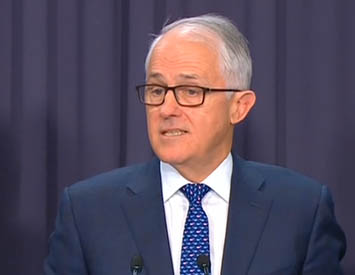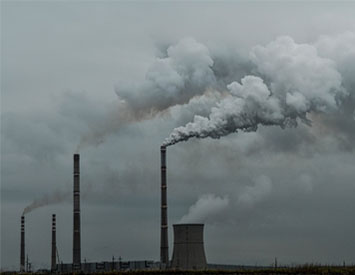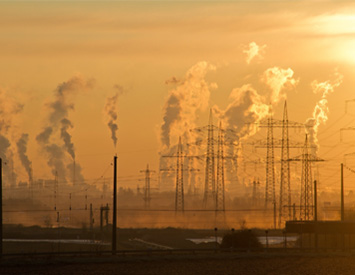RenewEconomy's Giles Parkinson analyses Malcolm Turnbull's efforts to distance himself from Abbott's environment policies and finds only verbal gymnastics and the same old slashing of clean energy funding.
PLUS çA CHANGE. The more it changes, the more it stays the same.
And that ageless expression seems to apply with Malcolm Turnbull’s desperate efforts to convince people that he is not Tony Abbott, that he is not the sword carrier for Abbott’s policies as his predecessor suggests and that he is not a slave to the conservative rump of his party.
Last week, Turnbull turned to clean energy to show that his spots are not the same as Abbott’s. If publicity and headlines are the main indicators, it has been a smashing success. Mainstream media has lapped it up: 'PM’s climate of change', hoorayed Fairfax. 'Coalition saves two clean energy funds', chorused the ABC. 'PM tilts at green windmills', booed the Murdoch media. (That editorial is probably worth a complete dissection on its own, so many errors, misconceptions and prejudices in such a few short paragraphs — but time is not infinite).
But what really happened last week?
In the face of opposition in the Senate, Turnbull bowed to the inevitable and decided to keep the Clean Energy Finance Corporation (CEFC). That is good. And that is change. The CEFC – once decried by its newest biggest supporter, Environment Minister Greg Hunt as a great big green hedge fund – has been behind many of the most important new clean energy projects and initiatives in the country, underwriting finance for large-scale solar projects, innovative solar thermal installations, battery storage trials and any amount of energy efficiency and rooftop solar support. And in doing this it has also delivered a significant return to the government. Hunt should now feel free to turn up at one of its project openings.
Turnbull then took $1 billion out of the CEFC kitty and rebadged it with his favourite buzzword, “innovation” and claimed the creation of a “new” thing called the “Clean Energy Innovation Fund”. But it does not represent new funding. It doesn’t really represent any new ideas. Instead it actually drip feeds those existing funds out over the next decade. If the opportunities were so great, the technology so compelling, and the need to act so imperative, why put the funds on slow release so a major portion cannot be spent until the mid 2020s? “So as not to overwhelm the market”, was the official explanation. Protecting the interests of incumbents and sheltering them from change might be a more believable take.
The coup de grâce, however, was the dismemberment of the Australian Renewable Energy Agency (ARENA), responsible for a host of ground breaking projects – on a local and global scale – over the last few years and often in co-operation with the CEFC. Again, judged by the mainstream media take, the PR on this was a smashing success – Turnbull retains ARENA, they crowed (or, in the case of the Murdoch media, complained). But ARENA will remain in name only. Its funding of $1.3 billion will be scrapped, and it will not even have the power to make calls over projects it will be asked to research for the new “innovation” fund.
This, says nearly everyone, will create a huge funding gap. And a big one, too. The very projects hailed and highlighted by Turnbull and Hunt – the Nyngan and Broken Hill solar farms – probably would not have been built without grant funds. Ditto the world-leading Carnegie Wave Energy project, and the first-of-their-kind solar and storage facilities being built at several major mine sites. These, more than anything, are discovery projects. They don’t all work. They are designed to show what is, or may not be, possible. They are not designed to make money. That’s not what happens at this point of the innovation chain. The former ARENA chairman, Greg Bourne, says this switch of focus to “money-making” rather than technology development could push much Australian innovation overseas.
This might have something to do with Turnbull’s background as an investment banker. Investment banks don’t do anything unless there is (a lot of) money in it. But the innovation chain of which Turnbull says he is so beguiled relies entirely on a whole range of grants, and high risk bets by high net worth individuals, angel investors and venture capitalists who hope that, maybe, just maybe, one of those bets might pay off.
ARENA’s role was to sift through the dozens of ideas that came through its doors and support the most worthy. Since it took back the decision making back from government bureaucrats, as it was designed to do because the bureaucrats were so inept, it has been a huge success.
But Hunt was damming of ARENA, accusing it in one sentence of “not following through” on investments, and then hailing the projects it funded in another. It just so happens that those solar projects, while benefiting from generous support, meant that the next round of funding could be decreased. By the time the next round of solar projects are ready to go, it is possible no additional support will be needed. That may not happen with the next round of technologies, however, under the new money-making funding regime.
But this is just part of the verbal gymnastics at which this Coalition – the first and second versions – is proving to be so adept.
Hunt, in a different time, hailed emissions trading as the best way to achieve emissions cuts. Now he says it is Direct Action. Hunt, at a different time, dismissed the CEFC as a great big hedge fund; now he says it is the key to unlocking innovation in solar, storage and smart grids.
Turnbull was damning of Direct Action as a fig leaf for climate change action and a recipe for financial disaster. Now he says that very same policy is the core of his emissions reductions strategy. He has left it untouched. Both Turnbull and Hunt claim emissions are going down, when in fact they are going up. Turnbull at a different time, turned up to applaud a proposal for 100 per cent renewables in the shortest time frame. Now he wants to control and slow the funding of new technologies so as “not to overwhelm the market.”
If Turnbull really wants to distinguish himself from Abbott-era policies, there is much he can do. Lift the country’s emissions reduction target, particularly in light of the terrifying new data on temperature rises and greenhouse emissions, not to mention the agreement made in Paris. He could dump the payment to polluters and make the polluters pay. He could find an effective way to force out coal-fired generation. A simple standard on emissions and longevity would do. He could fix the obvious holes in the renewable energy target that are being exploited by the coal fired generators. He could fast-track emissions and energy efficiency standards so that they lead the world, rather than lag it. He could speak of a vision for a clean energy future rather than pretending that coal is the key to unlocking global poverty.
But he can’t and he won’t. For the time being, and for an uncertain period into the future, he has to wear Abbott’s policies. And that simple fact leads to another question which is just a little difficult to visualise: Is Turnbull also obliged to wearing Abbott’s budgie smugglers too?
This story was originally published in RenewEconomy on 24 March 2016 and has been republished with permission. You can follow Giles on Twitter @GilesParkinson.
Monthly Donation
Single Donation
Keep up! Subscribe to IA for just $5.









